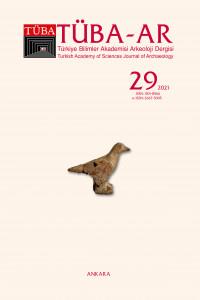Abstract
Erken Kalkolitik Dönem Neolitik köy yaşamının devam ettiği, bız ve benzeri bakır aletlerin buluntu topluluğuna eklendiği, boya bezemeli çanak çömleğin gelişip yaygınlaştığı bir dönem olarak tanımlanmaktadır. Boya bezemeli çanak çömlek Anadolu’nun güneybatısında ilk kez Neolitik Dönemde görülmekte olup Kalkolitik Dönemde gelişerek devam etmiştir. Konya Ovasında ise boyalı çanak çömlek Neolitik Dönem’de zayıf veriler ile temsil edilmekteyken, Erken Kalkolitik Dönem’de ovanın tamamında yaygın olup baskın çanak çömlek grubunu oluşturmaktadır. Konya Ovası'nın Neolitik ve Erken Kalkolitik Dönemi hakkında yapılan etkileyici araştırmalara rağmen bu dönemlerin çanak çömlek buluntuları üzerine çok az yayın mevcuttur. Burada sunulan analiz, Michele Massa ve Christoph Bachhuber tarafından ortaklaşa yürütülen KRASP projesinden (www.krasp.net), 1950'lerde David French ve James Mellaart'ın araştırmalarından elde edilen ve Ankara İngiliz Arkeoloji Enstitüsü’nde bulunan buluntuları kapsamaktadır. Erken Kalkolitik Dönem'e ait özgün ve kolayca tanımlanabilen krem üzerine kırmızı boyalı bu çanak çömleğin burada, tipoloji, mal grubu, bezeme analizi ve bölgesel bir karşılaştırması sunulmaktadır. Değerlendirme sonuçlarıyla Konya Ovası ile çevre bölgeler arasındaki çanak çömlek etkileşim ağlarına yeni bir yorum getirilerek, MÖ 7. binyıl sonu, 6. Binyıl başında Konya Ovasının Erken Kalkolitik toplulukların yayılımının daha iyi anlaşılması sağlanmaktadır.
Keywords
Erken Kalkolitik Dönem MÖ 6000-5500 Konya Ovası Boya Bezemeli Çanak Çömlek Beyaz Üzeri Kırmızı Bezemeli Çanak Çömlek.
References
- MASSA, M./BACHUBER, C./ŞAHİN, F./BOSTANCI KOLANKAYA, N./TUNA, Y. 2019; “The Konya Regional Archaeological Survey Project. The 2017 and 2018 Field Seasons”, Anatolica XLV: 159-180.
Abstract
The Early Chalcolithic is a phase characterised by the expansion of the Neolithic way of life, the production of basic copper tools and the widespread manufacture of painted pottery. In particular, painted pottery is seen for the first time in the Late Neolithic of southwestern Anatolia, and gradually developed in the following Chalcolithic period. In the Konya Plain, this type of pottery probably starts at the end of the 7th millennium BC but becomes widespread only in the early 6th millennum BC, when it often accounts for a large proportion of the diagnostic assemblages.
Despite the large volume of research regarding the Neolithic and Early Chalcolithic in the region, there are very few publications about the ceramics of this period. The analysis presented here includes finds from the KRASP project (www.krasp.net), jointly run by Michele Massa and Christoph Bachhuber, as well as finds from survey collections conducted by David French and James Mellaart in the 1950s and now stored at the British Institute at Ankara. The article presents a detailed form typology, ware group classification, decoration analysis and a regional comparison of this unique and easily identifiable red-on-cream painted pottery from the Early Chalcolithic period. The analytical results suggest a wide network of contacts between the Konya Plain communities and those of surrounding regions, and help to contextualise the expansion of the sedentary life-style in the region between the end of the 7th and the early 6th millennia BC.
Keywords
Early Chalcolithic Period 6000-5500 BC Konya Plain Paint Decorated Pottery Red on White Decorated Pottery.
References
- MASSA, M./BACHUBER, C./ŞAHİN, F./BOSTANCI KOLANKAYA, N./TUNA, Y. 2019; “The Konya Regional Archaeological Survey Project. The 2017 and 2018 Field Seasons”, Anatolica XLV: 159-180.
Details
| Primary Language | Turkish |
|---|---|
| Subjects | Archaeology |
| Journal Section | Research Articles |
| Authors | |
| Early Pub Date | December 29, 2021 |
| Publication Date | December 31, 2021 |
| Submission Date | August 5, 2021 |
| Published in Issue | Year 2021 Issue: 29 |
Cite
The contents of this system and all articles published in Journal of TÜBA-AR are licenced under the "Creative Commons Attribution-NonCommercial-NoDerivatives 4.0".



